technical specifications FIAT SCUDO 2010 Owner handbook (in English)
[x] Cancel search | Manufacturer: FIAT, Model Year: 2010, Model line: SCUDO, Model: FIAT SCUDO 2010Pages: 210, PDF Size: 3.32 MB
Page 165 of 210
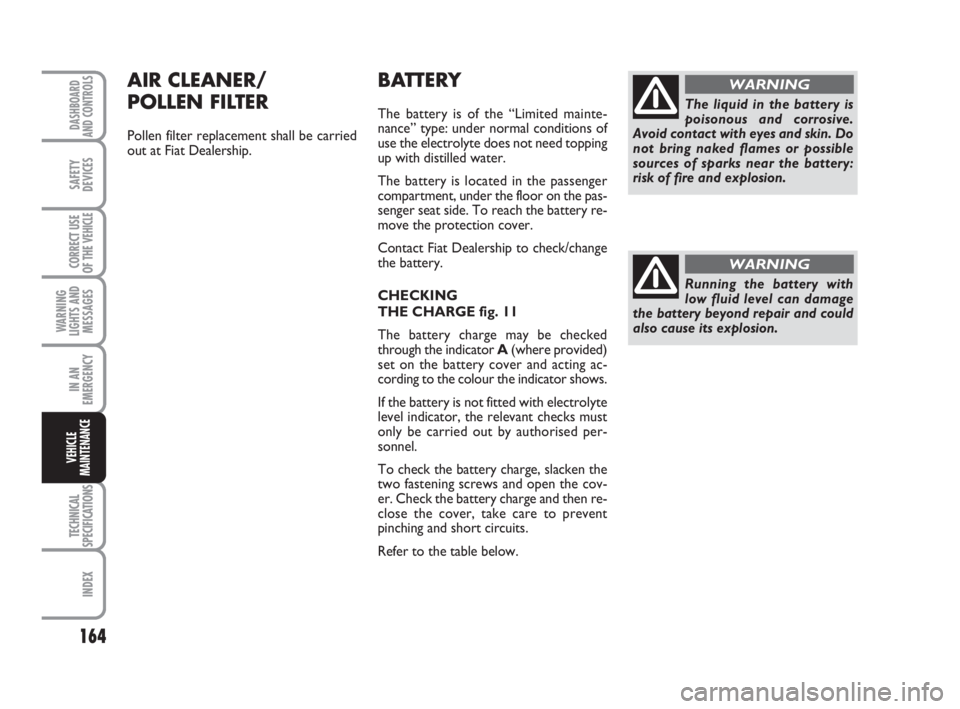
164
WARNING
LIGHTS AND
MESSAGES
TECHNICAL
SPECIFICATIONS
INDEX
DASHBOARD
AND CONTROLS
SAFETY
DEVICES
CORRECT USE
OF THE
VEHICLE
IN AN
EMERGENCY
VEHICLE
MAINTENANCE
BATTERY
The battery is of the “Limited mainte-
nance” type: under normal conditions of
use the electrolyte does not need topping
up with distilled water.
The battery is located in the passenger
compartment, under the floor on the pas-
senger seat side. To reach the battery re-
move the protection cover.
Contact Fiat Dealership to check/change
the battery.
CHECKING
THE CHARGE fig. 11
The battery charge may be checked
through the indicator A(where provided)
set on the battery cover and acting ac-
cording to the colour the indicator shows.
If the battery is not fitted with electrolyte
level indicator, the relevant checks must
only be carried out by authorised per-
sonnel.
To check the battery charge, slacken the
two fastening screws and open the cov-
er. Check the battery charge and then re-
close the cover, take care to prevent
pinching and short circuits.
Refer to the table below.The liquid in the battery is
poisonous and corrosive.
Avoid contact with eyes and skin. Do
not bring naked flames or possible
sources of sparks near the battery:
risk of fire and explosion.
WARNING
Running the battery with
low fluid level can damage
the battery beyond repair and could
also cause its explosion.
WARNING
AIR CLEANER/
POLLEN FILTER
Pollen filter replacement shall be carried
out at Fiat Dealership.
153-172 Nuovo ScudoG9 GB:153-172 Nuovo ScudoG9 GB 16-11-2009 12:05 Pagina 164
Page 166 of 210
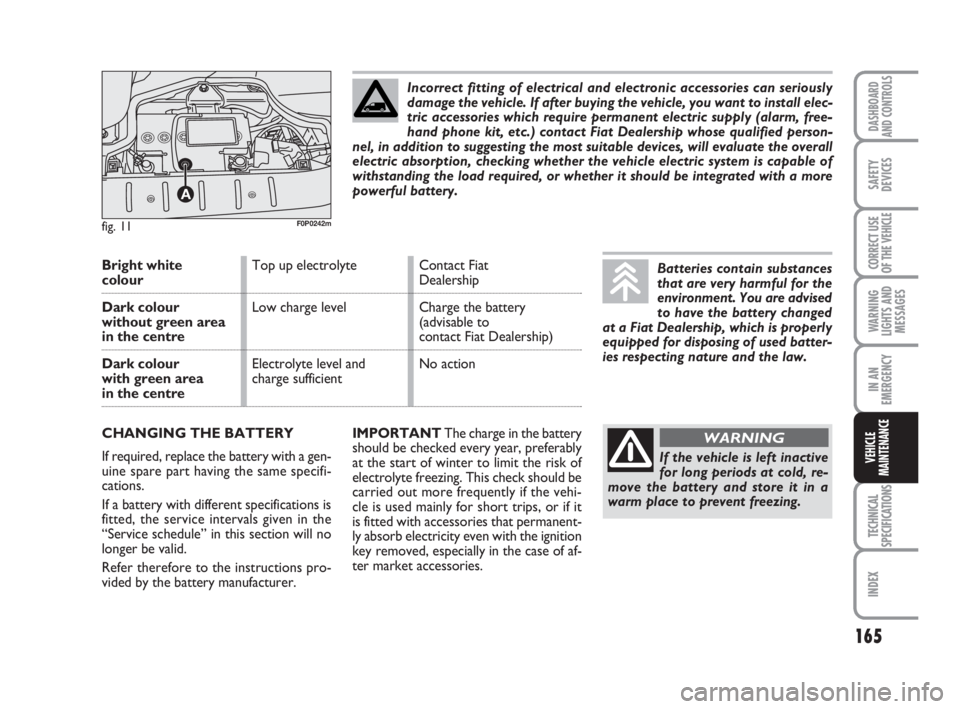
165
WARNING
LIGHTS AND
MESSAGES
TECHNICAL
SPECIFICATIONS
INDEX
DASHBOARD
AND CONTROLS
SAFETY
DEVICES
CORRECT USE
OF THE
VEHICLE
IN AN
EMERGENCY
VEHICLE
MAINTENANCE
IMPORTANTThe charge in the battery
should be checked every year, preferably
at the start of winter to limit the risk of
electrolyte freezing. This check should be
carried out more frequently if the vehi-
cle is used mainly for short trips, or if it
is fitted with accessories that permanent-
ly absorb electricity even with the ignition
key removed, especially in the case of af-
ter market accessories.
fig. 11
A
F0P0242m
Bright whiteTop up electrolyte Contact Fiat colourDealership
Dark colourLow charge level Charge the battery
without green area (advisable to
in the centrecontact Fiat Dealership)
Dark colour Electrolyte level and No action
with green area charge sufficient
in the centre
CHANGING THE BATTERY
If required, replace the battery with a gen-
uine spare part having the same specifi-
cations.
If a battery with different specifications is
fitted, the service intervals given in the
“Service schedule” in this section will no
longer be valid.
Refer therefore to the instructions pro-
vided by the battery manufacturer.Incorrect fitting of electrical and electronic accessories can seriously
damage the vehicle. If after buying the vehicle, you want to install elec-
tric accessories which require permanent electric supply (alarm, free-
hand phone kit, etc.) contact Fiat Dealership whose qualified person-
nel, in addition to suggesting the most suitable devices, will evaluate the overall
electric absorption, checking whether the vehicle electric system is capable of
withstanding the load required, or whether it should be integrated with a more
powerful battery.
Batteries contain substances
that are very harmful for the
environment. You are advised
to have the battery changed
at a Fiat Dealership, which is properly
equipped for disposing of used batter-
ies respecting nature and the law.
If the vehicle is left inactive
for long periods at cold, re-
move the battery and store it in a
warm place to prevent freezing.
WARNING
153-172 Nuovo ScudoG9 GB:153-172 Nuovo ScudoG9 GB 16-11-2009 12:05 Pagina 165
Page 167 of 210
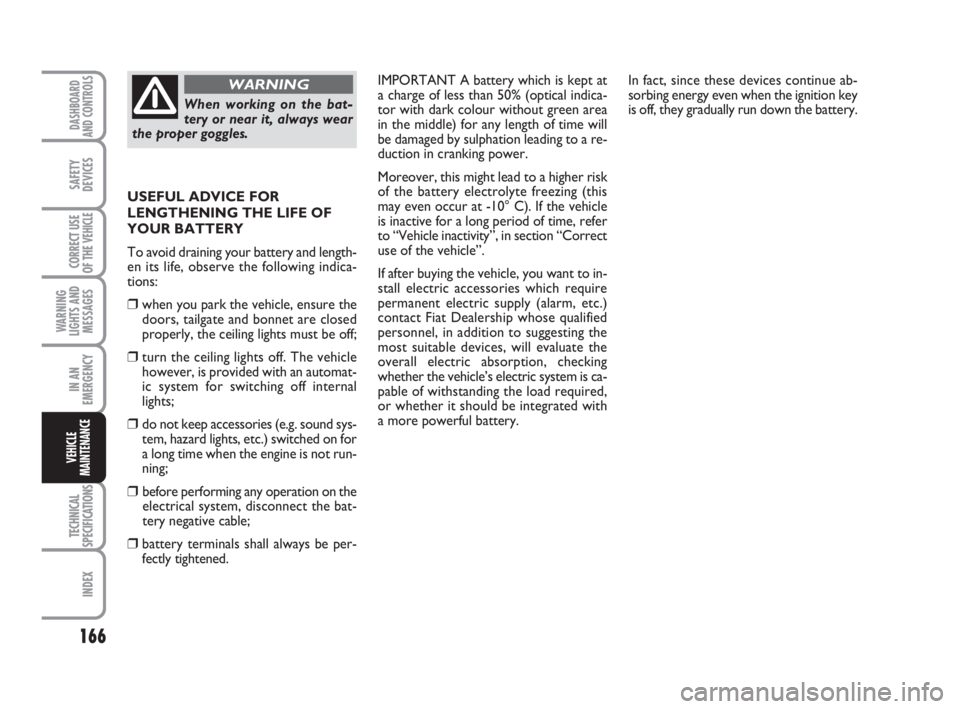
166
WARNING
LIGHTS AND
MESSAGES
TECHNICAL
SPECIFICATIONS
INDEX
DASHBOARD
AND CONTROLS
SAFETY
DEVICES
CORRECT USE
OF THE
VEHICLE
IN AN
EMERGENCY
VEHICLE
MAINTENANCE
IMPORTANT A battery which is kept at
a charge of less than 50% (optical indica-
tor with dark colour without green area
in the middle) for any length of time will
be damaged by sulphation leading to a re-
duction in cranking power.
Moreover, this might lead to a higher risk
of the battery electrolyte freezing (this
may even occur at -10° C). If the vehicle
is inactive for a long period of time, refer
to “Vehicle inactivity”, in section “Correct
use of the vehicle”.
If after buying the vehicle, you want to in-
stall electric accessories which require
permanent electric supply (alarm, etc.)
contact Fiat Dealership whose qualified
personnel, in addition to suggesting the
most suitable devices, will evaluate the
overall electric absorption, checking
whether the vehicle’s electric system is ca-
pable of withstanding the load required,
or whether it should be integrated with
a more powerful battery. USEFUL ADVICE FOR
LENGTHENING THE LIFE OF
YOUR BATTERY
To avoid draining your battery and length-
en its life, observe the following indica-
tions:
❒when you park the vehicle, ensure the
doors, tailgate and bonnet are closed
properly, the ceiling lights must be off;
❒turn the ceiling lights off. The vehicle
however, is provided with an automat-
ic system for switching off internal
lights;
❒do not keep accessories (e.g. sound sys-
tem, hazard lights, etc.) switched on for
a long time when the engine is not run-
ning;
❒ before performing any operation on the
electrical system, disconnect the bat-
tery negative cable;
❒battery terminals shall always be per-
fectly tightened.
When working on the bat-
tery or near it, always wear
the proper goggles.
WARNINGIn fact, since these devices continue ab-
sorbing energy even when the ignition key
is off, they gradually run down the battery.
153-172 Nuovo ScudoG9 GB:153-172 Nuovo ScudoG9 GB 16-11-2009 12:05 Pagina 166
Page 168 of 210
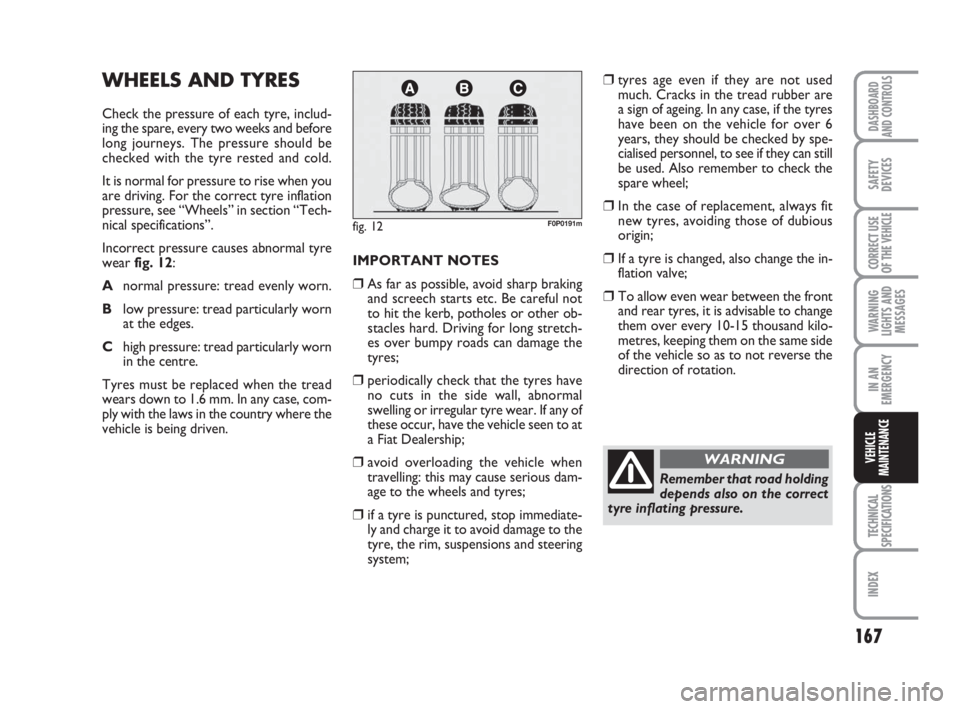
167
WARNING
LIGHTS AND
MESSAGES
TECHNICAL
SPECIFICATIONS
INDEX
DASHBOARD
AND CONTROLS
SAFETY
DEVICES
CORRECT USE
OF THE
VEHICLE
IN AN
EMERGENCY
VEHICLE
MAINTENANCE
WHEELS AND TYRES
Check the pressure of each tyre, includ-
ing the spare, every two weeks and before
long journeys. The pressure should be
checked with the tyre rested and cold.
It is normal for pressure to rise when you
are driving. For the correct tyre inflation
pressure, see “Wheels” in section “Tech-
nical specifications”.
Incorrect pressure causes abnormal tyre
wearfig. 12:
Anormal pressure: tread evenly worn.
Blow pressure: tread particularly worn
at the edges.
Chigh pressure: tread particularly worn
in the centre.
Tyres must be replaced when the tread
wears down to 1.6 mm. In any case, com-
ply with the laws in the country where the
vehicle is being driven.
fig. 12F0P0191m
IMPORTANT NOTES
❒As far as possible, avoid sharp braking
and screech starts etc. Be careful not
to hit the kerb, potholes or other ob-
stacles hard. Driving for long stretch-
es over bumpy roads can damage the
tyres;
❒periodically check that the tyres have
no cuts in the side wall, abnormal
swelling or irregular tyre wear. If any of
these occur, have the vehicle seen to at
a Fiat Dealership;
❒avoid overloading the vehicle when
travelling: this may cause serious dam-
age to the wheels and tyres;
❒if a tyre is punctured, stop immediate-
ly and charge it to avoid damage to the
tyre, the rim, suspensions and steering
system;
❒tyres age even if they are not used
much. Cracks in the tread rubber are
a sign of ageing. In any case, if the tyres
have been on the vehicle for over 6
years, they should be checked by spe-
cialised personnel, to see if they can still
be used. Also remember to check the
spare wheel;
❒ In the case of replacement, always fit
new tyres, avoiding those of dubious
origin;
❒ If a tyre is changed, also change the in-
flation valve;
❒To allow even wear between the front
and rear tyres, it is advisable to change
them over every 10-15 thousand kilo-
metres, keeping them on the same side
of the vehicle so as to not reverse the
direction of rotation.
Remember that road holding
depends also on the correct
tyre inflating pressure.
WARNING
153-172 Nuovo ScudoG9 GB:153-172 Nuovo ScudoG9 GB 16-11-2009 12:05 Pagina 167
Page 169 of 210
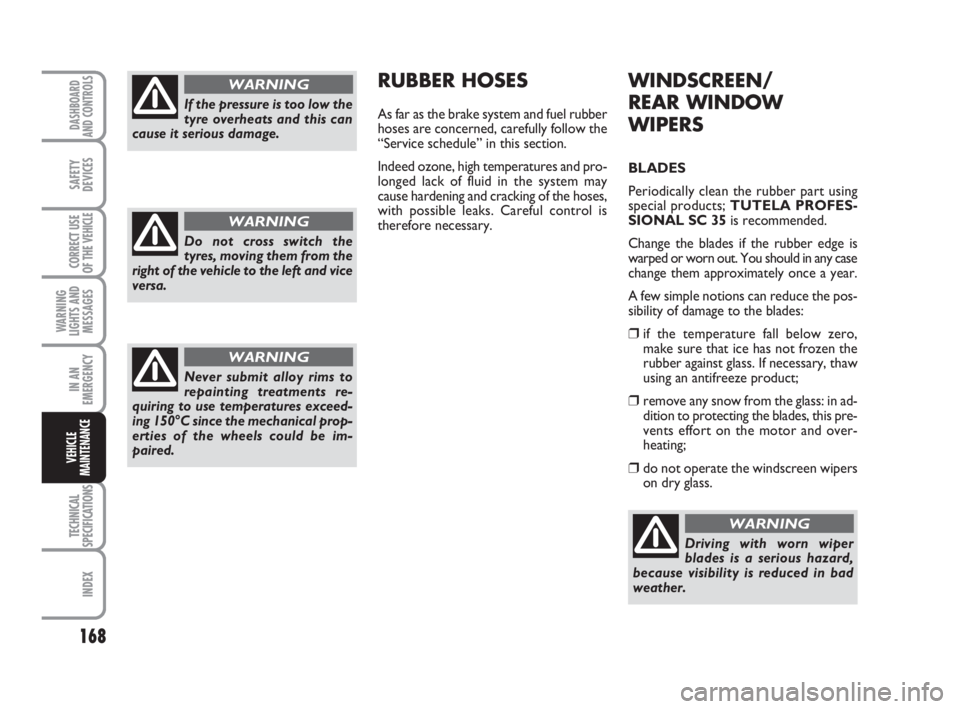
168
WARNING
LIGHTS AND
MESSAGES
TECHNICAL
SPECIFICATIONS
INDEX
DASHBOARD
AND CONTROLS
SAFETY
DEVICES
CORRECT USE
OF THE
VEHICLE
IN AN
EMERGENCY
VEHICLE
MAINTENANCE
WINDSCREEN/
REAR WINDOW
WIPERS
BLADES
Periodically clean the rubber part using
special products; TUTELA PROFES-
SIONAL SC 35is recommended.
Change the blades if the rubber edge is
warped or worn out. You should in any case
change them approximately once a year.
A few simple notions can reduce the pos-
sibility of damage to the blades:
❒ if the temperature fall below zero,
make sure that ice has not frozen the
rubber against glass. If necessary, thaw
using an antifreeze product;
❒ remove any snow from the glass: in ad-
dition to protecting the blades, this pre-
vents effort on the motor and over-
heating;
❒do not operate the windscreen wipers
on dry glass.
Driving with worn wiper
blades is a serious hazard,
because visibility is reduced in bad
weather.
WARNING
RUBBER HOSES
As far as the brake system and fuel rubber
hoses are concerned, carefully follow the
“Service schedule” in this section.
Indeed ozone, high temperatures and pro-
longed lack of fluid in the system may
cause hardening and cracking of the hoses,
with possible leaks. Careful control is
therefore necessary.If the pressure is too low the
tyre overheats and this can
cause it serious damage.
WARNING
Do not cross switch the
tyres, moving them from the
right of the vehicle to the left and vice
versa.
WARNING
Never submit alloy rims to
repainting treatments re-
quiring to use temperatures exceed-
ing 150°C since the mechanical prop-
erties of the wheels could be im-
paired.
WARNING
153-172 Nuovo ScudoG9 GB:153-172 Nuovo ScudoG9 GB 16-11-2009 12:05 Pagina 168
Page 170 of 210
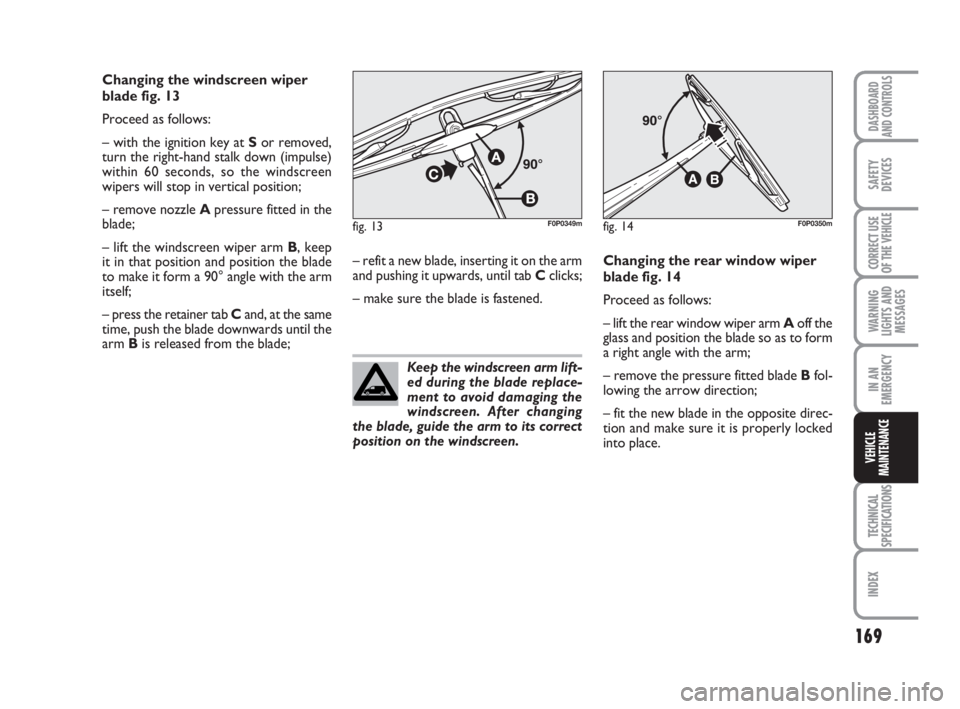
169
WARNING
LIGHTS AND
MESSAGES
TECHNICAL
SPECIFICATIONS
INDEX
DASHBOARD
AND CONTROLS
SAFETY
DEVICES
CORRECT USE
OF THE
VEHICLE
IN AN
EMERGENCY
VEHICLE
MAINTENANCE
Changing the windscreen wiper
blade fig. 13
Proceed as follows:
– with the ignition key at Sor removed,
turn the right-hand stalk down (impulse)
within 60 seconds, so the windscreen
wipers will stop in vertical position;
– remove nozzle Apressure fitted in the
blade;
– lift the windscreen wiper arm B, keep
it in that position and position the blade
to make it form a 90° angle with the arm
itself;
– press the retainer tab Cand, at the same
time, push the blade downwards until the
arm Bis released from the blade;– refit a new blade, inserting it on the arm
and pushing it upwards, until tab Cclicks;
– make sure the blade is fastened.Changing the rear window wiper
blade fig. 14
Proceed as follows:
– lift the rear window wiper arm Aoff the
glass and position the blade so as to form
a right angle with the arm;
– remove the pressure fitted blade Bfol-
lowing the arrow direction;
– fit the new blade in the opposite direc-
tion and make sure it is properly locked
into place. Keep the windscreen arm lift-
ed during the blade replace-
ment to avoid damaging the
windscreen. After changing
the blade, guide the arm to its correct
position on the windscreen.
fig. 13F0P0349mfig. 14F0P0350m
153-172 Nuovo ScudoG9 GB:153-172 Nuovo ScudoG9 GB 16-11-2009 12:05 Pagina 169
Page 171 of 210
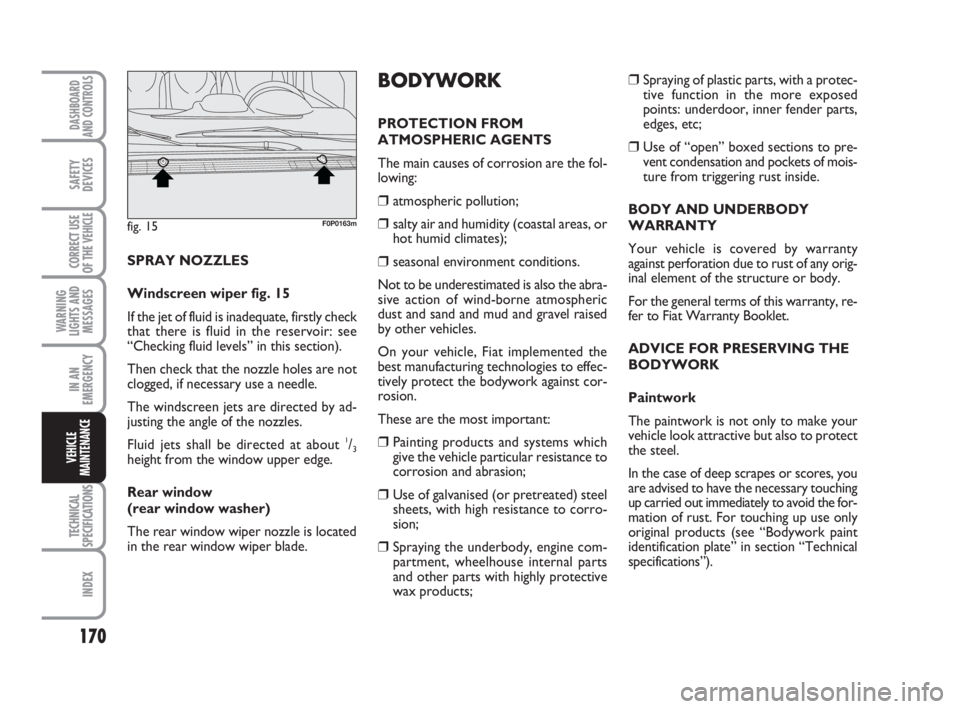
170
WARNING
LIGHTS AND
MESSAGES
TECHNICAL
SPECIFICATIONS
INDEX
DASHBOARD
AND CONTROLS
SAFETY
DEVICES
CORRECT USE
OF THE
VEHICLE
IN AN
EMERGENCY
VEHICLE
MAINTENANCE
❒Spraying of plastic parts, with a protec-
tive function in the more exposed
points: underdoor, inner fender parts,
edges, etc;
❒ Use of “open” boxed sections to pre-
vent condensation and pockets of mois-
ture from triggering rust inside.
BODY AND UNDERBODY
WARRANTY
Your vehicle is covered by warranty
against perforation due to rust of any orig-
inal element of the structure or body.
For the general terms of this warranty, re-
fer to Fiat Warranty Booklet.
ADVICE FOR PRESERVING THE
BODYWORK
Paintwork
The paintwork is not only to make your
vehicle look attractive but also to protect
the steel.
In the case of deep scrapes or scores, you
are advised to have the necessary touching
up carried out immediately to avoid the for-
mation of rust. For touching up use only
original products (see “Bodywork paint
identification plate” in section “Technical
specifications”).
BODYWORK
PROTECTION FROM
ATMOSPHERIC AGENTS
The main causes of corrosion are the fol-
lowing:
❒ atmospheric pollution;
❒ salty air and humidity (coastal areas, or
hot humid climates);
❒ seasonal environment conditions.
Not to be underestimated is also the abra-
sive action of wind-borne atmospheric
dust and sand and mud and gravel raised
by other vehicles.
On your vehicle, Fiat implemented the
best manufacturing technologies to effec-
tively protect the bodywork against cor-
rosion.
These are the most important:
❒ Painting products and systems which
give the vehicle particular resistance to
corrosion and abrasion;
❒ Use of galvanised (or pretreated) steel
sheets, with high resistance to corro-
sion;
❒ Spraying the underbody, engine com-
partment, wheelhouse internal parts
and other parts with highly protective
wax products; SPRAY NOZZLES
Windscreen wiper fig. 15
If the jet of fluid is inadequate, firstly check
that there is fluid in the reservoir: see
“Checking fluid levels” in this section).
Then check that the nozzle holes are not
clogged, if necessary use a needle.
The windscreen jets are directed by ad-
justing the angle of the nozzles.
Fluid jets shall be directed at about
1/3height from the window upper edge.
Rear window
(rear window washer)
The rear window wiper nozzle is located
in the rear window wiper blade.
fig. 15F0P0163m
153-172 Nuovo ScudoG9 GB:153-172 Nuovo ScudoG9 GB 16-11-2009 12:05 Pagina 170
Page 172 of 210
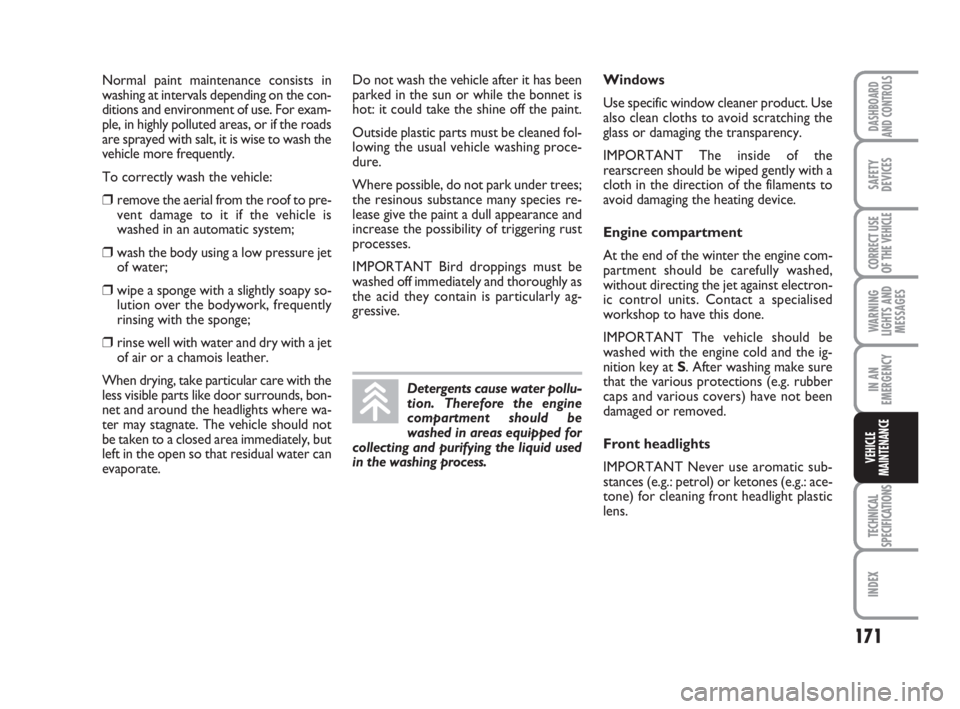
171
WARNING
LIGHTS AND
MESSAGES
TECHNICAL
SPECIFICATIONS
INDEX
DASHBOARD
AND CONTROLS
SAFETY
DEVICES
CORRECT USE
OF THE
VEHICLE
IN AN
EMERGENCY
VEHICLE
MAINTENANCE
Normal paint maintenance consists in
washing at intervals depending on the con-
ditions and environment of use. For exam-
ple, in highly polluted areas, or if the roads
are sprayed with salt, it is wise to wash the
vehicle more frequently.
To correctly wash the vehicle:
❒ remove the aerial from the roof to pre-
vent damage to it if the vehicle is
washed in an automatic system;
❒ wash the body using a low pressure jet
of water;
❒ wipe a sponge with a slightly soapy so-
lution over the bodywork, frequently
rinsing with the sponge;
❒ rinse well with water and dry with a jet
of air or a chamois leather.
When drying, take particular care with the
less visible parts like door surrounds, bon-
net and around the headlights where wa-
ter may stagnate. The vehicle should not
be taken to a closed area immediately, but
left in the open so that residual water can
evaporate.Do not wash the vehicle after it has been
parked in the sun or while the bonnet is
hot: it could take the shine off the paint.
Outside plastic parts must be cleaned fol-
lowing the usual vehicle washing proce-
dure.
Where possible, do not park under trees;
the resinous substance many species re-
lease give the paint a dull appearance and
increase the possibility of triggering rust
processes.
IMPORTANT Bird droppings must be
washed off immediately and thoroughly as
the acid they contain is particularly ag-
gressive.
Detergents cause water pollu-
tion. Therefore the engine
compartment should be
washed in areas equipped for
collecting and purifying the liquid used
in the washing process.
Windows
Use specific window cleaner product. Use
also clean cloths to avoid scratching the
glass or damaging the transparency.
IMPORTANT The inside of the
rearscreen should be wiped gently with a
cloth in the direction of the filaments to
avoid damaging the heating device.
Engine compartment
At the end of the winter the engine com-
partment should be carefully washed,
without directing the jet against electron-
ic control units. Contact a specialised
workshop to have this done.
IMPORTANT The vehicle should be
washed with the engine cold and the ig-
nition key at S. After washing make sure
that the various protections (e.g. rubber
caps and various covers) have not been
damaged or removed.
Front headlights
IMPORTANT Never use aromatic sub-
stances (e.g.: petrol) or ketones (e.g.: ace-
tone) for cleaning front headlight plastic
lens.
153-172 Nuovo ScudoG9 GB:153-172 Nuovo ScudoG9 GB 16-11-2009 12:05 Pagina 171
Page 173 of 210
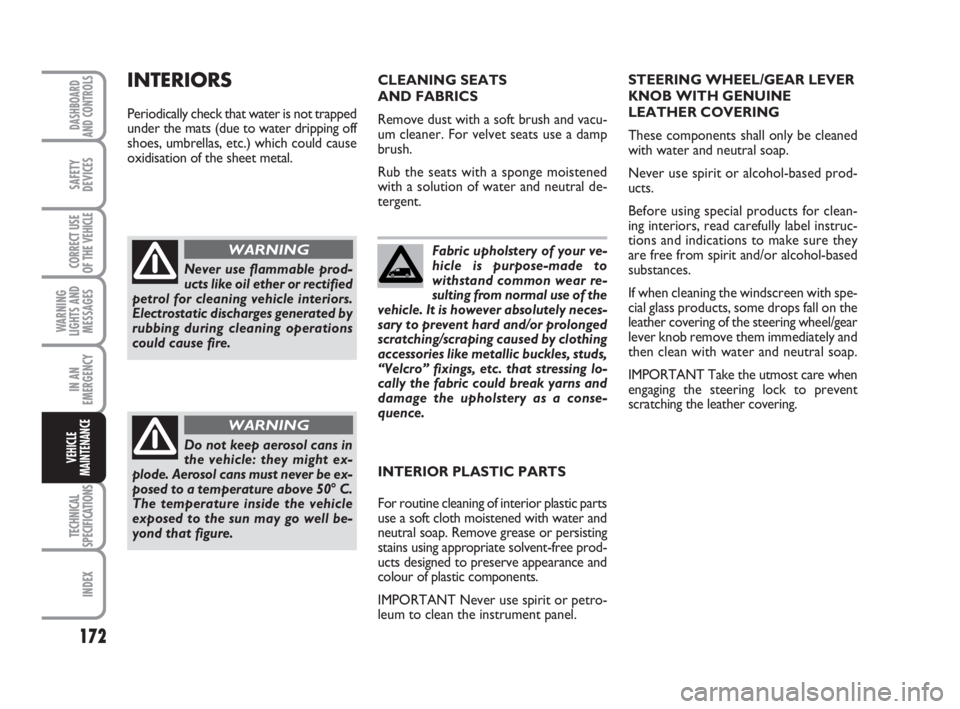
172
WARNING
LIGHTS AND
MESSAGES
TECHNICAL
SPECIFICATIONS
INDEX
DASHBOARD
AND CONTROLS
SAFETY
DEVICES
CORRECT USE
OF THE
VEHICLE
IN AN
EMERGENCY
VEHICLE
MAINTENANCE
Fabric upholstery of your ve-
hicle is purpose-made to
withstand common wear re-
sulting from normal use of the
vehicle. It is however absolutely neces-
sary to prevent hard and/or prolonged
scratching/scraping caused by clothing
accessories like metallic buckles, studs,
“Velcro” fixings, etc. that stressing lo-
cally the fabric could break yarns and
damage the upholstery as a conse-
quence. CLEANING SEATS
AND FABRICS
Remove dust with a soft brush and vacu-
um cleaner. For velvet seats use a damp
brush.
Rub the seats with a sponge moistened
with a solution of water and neutral de-
tergent.
Never use flammable prod-
ucts like oil ether or rectified
petrol for cleaning vehicle interiors.
Electrostatic discharges generated by
rubbing during cleaning operations
could cause fire.
WARNING
Do not keep aerosol cans in
the vehicle: they might ex-
plode. Aerosol cans must never be ex-
posed to a temperature above 50° C.
The temperature inside the vehicle
exposed to the sun may go well be-
yond that figure.
WARNING
INTERIORS
Periodically check that water is not trapped
under the mats (due to water dripping off
shoes, umbrellas, etc.) which could cause
oxidisation of the sheet metal.STEERING WHEEL/GEAR LEVER
KNOB WITH GENUINE
LEATHER COVERING
These components shall only be cleaned
with water and neutral soap.
Never use spirit or alcohol-based prod-
ucts.
Before using special products for clean-
ing interiors, read carefully label instruc-
tions and indications to make sure they
are free from spirit and/or alcohol-based
substances.
If when cleaning the windscreen with spe-
cial glass products, some drops fall on the
leather covering of the steering wheel/gear
lever knob remove them immediately and
then clean with water and neutral soap.
IMPORTANT Take the utmost care when
engaging the steering lock to prevent
scratching the leather covering.
INTERIOR PLASTIC PARTS
For routine cleaning of interior plastic parts
use a soft cloth moistened with water and
neutral soap. Remove grease or persisting
stains using appropriate solvent-free prod-
ucts designed to preserve appearance and
colour of plastic components.
IMPORTANT Never use spirit or petro-
leum to clean the instrument panel.
153-172 Nuovo ScudoG9 GB:153-172 Nuovo ScudoG9 GB 16-11-2009 12:05 Pagina 172
Page 174 of 210
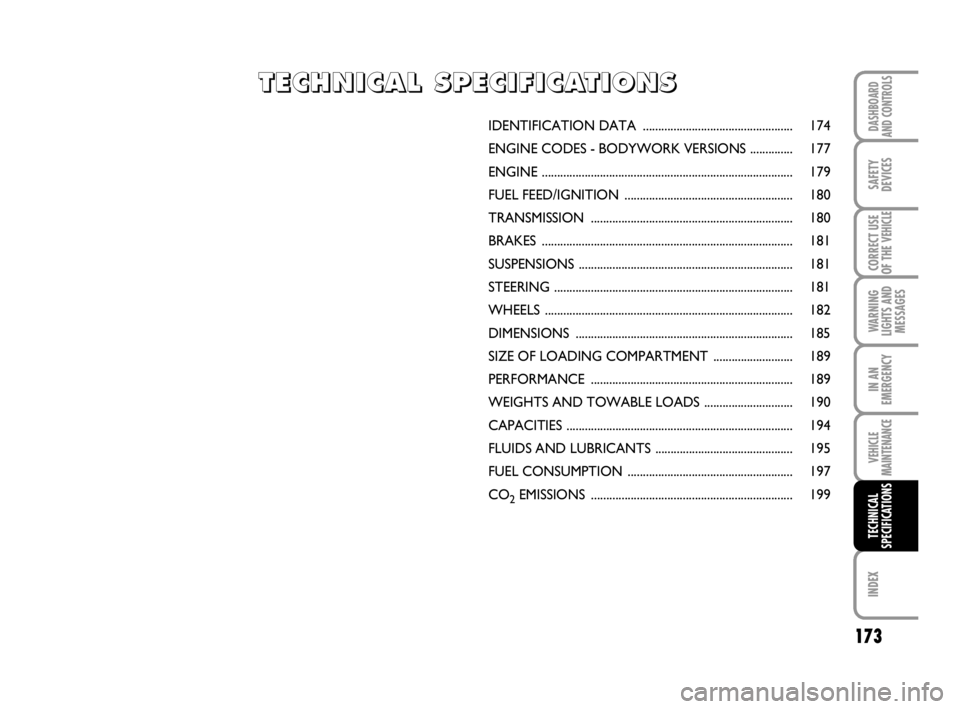
173
WARNING
LIGHTS AND
MESSAGES
INDEX
DASHBOARD
AND CONTROLS
SAFETY
DEVICES
CORRECT USE
OF THE
VEHICLE
IN AN
EMERGENCY
VEHICLE
MAINTENANCE
TECHNICAL
SPECIFICATIONS
IDENTIFICATION DATA ................................................. 174
ENGINE CODES - BODYWORK VERSIONS .............. 177
ENGINE .................................................................................. 179
FUEL FEED/IGNITION ....................................................... 180
TRANSMISSION .................................................................. 180
BRAKES .................................................................................. 181
SUSPENSIONS ...................................................................... 181
STEERING .............................................................................. 181
WHEELS ................................................................................. 182
DIMENSIONS ....................................................................... 185
SIZE OF LOADING COMPARTMENT .......................... 189
PERFORMANCE .................................................................. 189
WEIGHTS AND TOWABLE LOADS ............................. 190
CAPACITIES .......................................................................... 194
FLUIDS AND LUBRICANTS ............................................. 195
FUEL CONSUMPTION ...................................................... 197
CO
2EMISSIONS .................................................................. 199
T T
E E
C C
H H
N N
I I
C C
A A
L L
S S
P P
E E
C C
I I
F F
I I
C C
A A
T T
I I
O O
N N
S S
173-199 Nuovo ScudoG9 GB.qxd:173-199 Nuovo ScudoG9 GB 10-12-09 16:17 Page 173